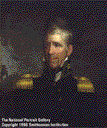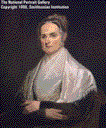

Elections and Voting
In the early days of the United States, the process of electing a president differed greatly from today's elections. In the late 1700s, only some white males could vote, and there were no political parties or nominating conventions as we think of them today. Here we feature Andrew Jackson, the father of modern party politics. We also spotlight two women who were instrumental in the suffrage movement, Lucretia Coffin Mott and Carrie Chapman Catt. Some people are surprised to learn that for much of our history, American women could not vote. Wyoming Territory was the first to allow women the right to vote in 1869, and continued that right after becoming a state in 1890. However, the right to vote for women did not become universal until August 26, 1920, when Tennessee became the last state needed to ratify the Nineteenth Amendment to the Constitution. The amendment prohibited denial of the vote on the basis of sex, and with its enactment, the crusade for women's suffrage, which had begun seventy-two years earlier at a women's-rights convention in Seneca Falls, New York, finally came to an end. Exhibits at the National Museum of American History tell more about suffrage and the woman's movement in many areas, including social reform.
 Ralph
Eleaser Whiteside Earl (1788?-1838)
Ralph
Eleaser Whiteside Earl (1788?-1838)
Andrew Jackson, the seventh president of the United States, from 1829 to 1837, helped to change both the nature of presidential elections and the character of the presidency. As a military officer, he had distinguished himself in the Battle of New Orleans during the War of 1812 and in various Indian conflicts. He possessed a strict moral code and on many occasions resorted to duels to protect his honor. His nickname, "Old Hickory," likened him to the toughest American hardwood.
Jackson was one of four candidates for the presidency in 1824, along with John Quincy Adams, Henry Clay, and William H. Crawford. In previous elections, presidential nominees had been selected by a congressional caucus or state legislatures. However, in 1824 all the candidates except Crawford won their nominations in state legislatures or local conventions. For voters, the common-born Jackson was a welcome change from the older generation of elite politicians, and he won a plurality of popular and electoral votes in the election. However, as no candidate received a majority of the electoral college vote, the contest was turned over to the House of Representatives. The choice was really between Jackson and Adams, as Crawford was no longer a favorable candidate because he became gravely ill after suffering a stroke, and Clay was not as popular as the others. In an exchange of political favors, Clay, the Speaker of the House, lent his support to Adams, who received the most votes. In return, Adams appointed Clay as his secretary of state. Jackson was outraged by what he called the "corrupt bargain."
Adams and Clay believed that the nation would best be served by a strong, activist federal government. Jacksonians, who came to be known as Democrats, were leery of centralized political and economic power and advocated the Jeffersonian concept of limited government, individual liberty, and states' rights. Between 1824 and 1828, Jackson and his associates worked at the grassroots level to build a popular-level opposition to Adams's administration. Average citizens became involved in politics in record numbers, as the Democrats organized local and state party conventions. The campaign of 1828 was one of the dirtiest in American history up to that point, in terms of back-stabbing and personal attacks. In the end, Jackson's appeal to the people paid off, when he was elected by a landslide.
President Jackson's aggressive use of the veto--a power that other presidents had used only sparingly--set a precedent for a much stronger presidential role in national policy-making. He also contributed to shaping the country's elective process: His was America's first modern political party, and never again would a candidate win the White House without engaging in party politics and making a direct appeal to the American people.
 Joseph
Kyle (1815-1863)
Joseph
Kyle (1815-1863)
Oil on canvas, 1842, NPG.74.72
National Portrait Gallery,
Smithsonian Institution, Washington, D.C.
Gift of Mrs. Alan Valentine
Lucretia Coffin Mott worked tirelessly for a number of causes during her lifetime, most notably the right of women to vote and the abolition of slavery. Reared in a Quaker community on the island of Nantucket, where women routinely shared responsibilities on an equal footing with men, she grew up assuming that equality between the sexes was an entirely reasonable proposition. By the age of thirteen, she discovered that most of the world did not share that outlook. She was indignant, and she resolved to make it her business to claim for women "all that an impartial Creator had bestowed" on humankind.
Mott became a Quaker minister at the age of twenty-eight. Her membership in the Quaker ministry helped prepare her for an active life of speaking and organizing. Like many of her faith, she denounced slavery, and in 1831 she made the acquaintance of abolitionist William Lloyd Garrison. Two years later, she attended the convention at which Garrison founded the American Anti-Slavery Society, which became the most radical of the abolitionist groups by calling for the immediate emancipation of black slaves. Mott proved her dedication to this cause by facing anti-abolitionist mobs and sheltering runaway slaves in her home. After the Civil War, Mott continued to press for African American suffrage and worked for the Friends Association of Philadelphia for the Aid and Elevation of the Freedmen.
While working for the abolitionist cause, Mott and other women reformers came to resent the gender discrimination inherent in the movement. Such discrimination was made painfully apparent during the 1840 World's Anti-Slavery Convention in London, at which women were allowed to attend only as spectators. Eight years later, Mott and Elizabeth Cady Stanton, who had also been present in London, called a convention in Seneca Falls, New York, to advocate women's rights. The convention passed a declaration which began, "We hold these truths to be self-evident, that all men and women are created equal." Soon, the fledgling women's movement began to concentrate on one key issue: the right to vote.
Throughout her life, Mott worked for various causes in addition to women's rights, including the Pennsylvania Peace Society and the establishment of Swarthmore College. Her lifelong dedication to reform made her one of the most influential and respected women of the nineteenth century.
 Mary
Foote (1872-1968)
Mary
Foote (1872-1968)
Oil on canvas, 1927, NPG.71.31
National Portrait Gallery,
Smithsonian Institution, Washington, D.C.
Transfer from the National Museum of American History; gift of the National
American Woman Suffrage Association through Mrs. Carrie Chapman Catt, 1939
Without Carrie Chapman Catt's masterful orchestration of the suffrage movement, women might have waited even longer for the right to vote. It was her determined leadership, more than any other factor, that carried the movement through the turmoil and instability of the early twentieth century to the final ratification of the Nineteenth Amendment in 1920.
Born Carrie Lane, she was raised in the frontier territories of Wisconsin and Iowa. As a child, Catt rejected traditional female roles in favor of a more active, self-reliant lifestyle. Although she was an excellent student, her father was reluctant to send her to college. Instead, after working for a time as a teacher, Catt put herself through Iowa State University with her own savings and hard labor. Although she originally set her sights on law school after graduating in 1880, instead she accepted a high school principalship in Mason City, Iowa. Two years later, she became superintendent of schools for Mason City. The determination and administrative skills that Catt developed during these years would serve her well during the fight for women's suffrage.
After less than two years of marriage, her first husband, Leo Chapman, died of typhoid fever. A year later, in 1887, she worked to organize the Iowa Woman Suffrage Association. In 1890, Catt represented Iowa women at a conference of the newly organized National American Woman Suffrage Association (NAWSA). This association united the disparate factions of the suffrage movement for the first time since 1869. That same year, she married George William Catt, a successful civil engineer who encouraged and underwrote her lifelong involvement in NAWSA's cause.
Catt's organizational skills, creativity, and magnetic personality helped her to quickly rise through the ranks of the suffrage movement. In 1895 she headed the NAWSA's Organization Committee, which oversaw far-flung membership and fund-raising activities. Five years later, Susan B. Anthony chose Catt to succeed her as president of the association. During these years Catt was also active in the International Woman Suffrage Alliance, attending eight European conferences from 1904 to 1923 and touring Europe, Africa, Asia, and South America in search of support. In America, Catt suggested the formation of a League of Women Voters to enhance the political role of women.
Though American suffragists were united around the turn of the century, the question of state versus federal activism remained. Catt was determined to concentrate on both. Wyoming, which as a territory had allowed women to vote since 1869, became the first state to grant universal suffrage in 1890. Gradually, more states followed Wyoming's example--fifteen in all by 1918. At the same time, women called on the president and Congress for a constitutional amendment. While World War I posed a potential threat to progress, it actually turned out to be a boon for women, who made themselves indispensable in the war effort. After much persuasion by Catt and others, President Woodrow Wilson even spoke out in favor of an amendment in 1918. A year later, the amendment passed both the House and the Senate, and in 1920 it was narrowly ratified by the requisite three-quarters of the states. It had been a long, hard struggle, but universal suffrage became a part of the United States Constitution, thanks to Catt and many others who devoted themselves to the cause.
LINKS
Andrew Jackson
The Suffrage Movement
Lucretia Coffin Mott
Carrie Chapman Catt